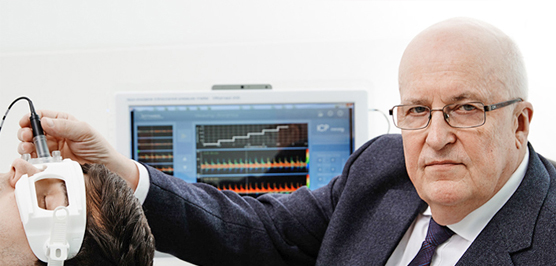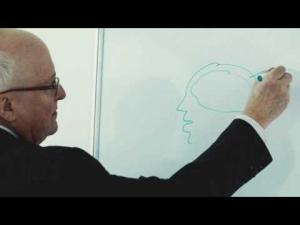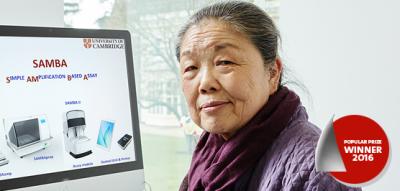Arminas Ragauskas
Ultrasound to safely measure brain pressure
Finalist for the European Inventor Award 2016
Quick response times are essential when diagnosing brain injury, especially when a brain trauma or tumour elevates cranial pressure to potentially lethal levels. Brought to market in 2015, two medical devices developed by Ragauskas and a team of fellow Lithuanian scientists give neurologists and other doctors precious extra time to detect and assess increased cranial pressure. They no longer need to resort to costly and time-consuming invasive surgery, which itself is not without risk.
Ragauskas - along with colleagues Gediminas Daubaris and Algis Dziugys from the Health Telematics Science Institute at Kaunas University of Technology, Lithuania - achieved a breakthrough by applying the Doppler wavelength effect in order to arrive at an accurate reading of cranial pressure, using an ingeniously simple formula. The team's devices compute the pressure differential between the inside and the outside of the skull, based on a quick and simple reading obtained from a sensor placed on the patient's eye.
Societal benefit
Traumatic brain injury (TBI) and central nervous system tumours rank among the leading causes of death worldwide. TBI is behind 30% of all injury deaths in the US and around 140 people die from the consequences of TBI every day, according to the US Center for Disease Control. In Europe, roughly 2.5 million people suffer a TBI each year and some 75 000 die as a result (CENTER-TBI).
The invented devices help to detect increased cranial pressure quickly and reliably, which is key in responding to TBI and brain tumours. They are a major improvement over invasive surgery, for which patients have to be anaesthetised. Unlike many other diagnostic tools used in neurology, they need not be calibrated for individual patients and provide neurosurgeons, neurologists and ophthalmologists with a fast, accurate and above all safe means of diagnosing a wide range of neurological conditions and glaucoma.
Economic benefit
Marketed by the inventor's start-up company Vittamed as non-invasive intracranial pressure meter Vittamed 205 and non-invasive cerebral auto-regulation monitor Vittamed 505, the devices received CE marking approval in 2014. The company, which has its headquarters in Kaunas, Lithuania, and in Lexington, US, is currently launching the products in Europe, Australia and the US, and recently secured Series A financing to the tune of EUR 8.79 million (USD 10 million) from Xeraya Capital Labuan Ltd.
The robust and accurate devices are garnering attention on the global brain-monitoring market, which includes diagnostic devices for TBI, strokes and tumours. The global market was worth EUR 6.6 billion (USD 7.5 billion) in 2015 (MarketsandMarkets) and is set to increase at a projected compound annual growth rate of 7% to reach EUR 10.5 billion (USD 11.5 billion) by 2020.
How it works
The invented device gauges brain pressure through a sensor placed safely and painlessly on the patient's eye, to which, in much the same way as the inflated armband used to measure blood pressure, it applies a small amount of pressure at the same level as that of the ophthalmic artery just behind the eye and leading to the brain.
This applied external pressure is then compared to the autonomous intracranial pressure (ICP). In a healthy adult, ICP is usually in the range of 0 to 10 mmHg (roughly 10% of the pressure created by the human heart to circulate blood). An ICP greater than 20 mmHg is considered abnormal. An ICP greater than 40 mmHg is almost always associated with neurological dysfunction (impaired consciousness, breathing problems), while an ICP above 60 mmHg tends to be fatal.
The inventors
Ragauskas developed an interest in measurement sciences as a young scientist and established the Telematics Science Laboratory at Kaunas University of Technology in 1993 to further his research. In 2013, he co-founded start-up company Vittamed, where he still serves as chief R&D officer, to bring the diagnostic tools to market.
During a career in measurement sciences spanning over 50 years, Ragauskas has written 91 peer-reviewed scientific papers and filed more than 90 granted or pending patent families. He is currently director of the Health Telematics Science Institute in Kaunas and national co‑ordinator of the CENTER-TBI project, which has a budget of EUR 30 million and 216 collaborators across the EU and is funded under the EU's 7th Framework Programme.
For his research in health telematics, Ragauskas received the Lithuanian Inventor of the Year award in 1981 and 1983. He has secured funding through more than 40 Lithuanian and international R&D grants from, among others, the European Commission, the US Department of Defense, the US Department of the Army and NASA.
Did you know?
The inventor's measuring devices are currently being used by the US National Space Biomedical Research Institute at a facility run by the German Aerospace Centre (DLR) in Cologne to investigate the effects of simulated spaceflight conditions on brain physiology.
All eyes are now on NASA's Scott and Mark Kelly, the only twins ever tested for the effects of long-duration space travel on the human body. Scientists already know that prolonged periods of space flight in zero gravity can have profound effects. The heart, for instance, tends to become more spherical and lose muscle mass due to the lack of gravity, which can cause problems on return to Earth.
Media gallery
Contact
European Inventor Award and Young Inventors Prize queries:
european-inventor@epo.org Subscribe to the European Inventor Award newsletterMedia-related queries:
Contact our Press team#InventorAward #YoungInventors














